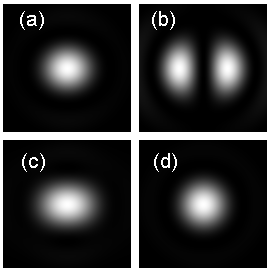|
When you focus an X polarised beam with a lens, what is the polarisation in the focal spot? The answer to this questions will depend on the numerical aperture (NA) of the focusing lens. The NA of the lens on the other hand depends on the angle made by a marginal ray with the optic axis. Higher the value of this angle, higher is the NA. For a low NA lens the focal spot is primarily X polarised, however, for a high NA lens there will be a considerable amount of Z polarised light in the focal spot in addition to the X polarised light. Figure 1(a) shows the focal intensity distribution considering X polarised light only, due to the focusing of an X polarised laser beam by a high NA (i.e. NA=1.2) lens. Figure 1(b) shows the corresponding Z polarised focal intensity distribution. For the above mentioned NA, the maximum of the Z polarised focal intensity is about 15% of the maximum X polarised focal intensity. Due to the presence of this significant amount of Z polarised light, in the form of a dumbbell along the X axis, the resultant focal intensity distribution is not circularly symmetric. Figure 1(c) shows the resultant focal intensity distribution, where, both X polarised intensity as in figure 1(a) and Z polarised intesity as in figure 1(b) are considered. Thus the focal spot in the high NA case is no longer an Airy pattern. However, if the same X polarised laser beam is focused by a low NA lens, the focal spot is circularly symmetric and is closely represented by an Airy pattern. This is because, in the low NA case, the Z polarised focal intensity distribution is too small to be considered. Figure 1(d) shows the resultant focal spot of an X polarised beam focused by a 0.1 NA lens. It is to be mentioned here that for an X polarised beam, contribution from the Y polarised light in the focal spot is negligible both in the high and low NA cases.
|

Figure 1: Simulated images of focal spots using high and low NA lenses.
|